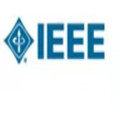We propose a time-adaptive predictor/multi-corrector method to solve hyperbolic partial differential equations, based on the generalized-$\alpha$ scheme that provides user-control on the numerical dissipation and second-order accuracy in time. Our time adaptivity uses an error estimation that exploits the recursive structure of the variable updates. The predictor/multicorrector method explicitly updates the equation system but computes the residual of the system implicitly. We analyze the method's stability and describe how to determine the parameters that ensure high-frequency dissipation and accurate low-frequency approximation. Subsequently, we solve a linear wave equation, followed by non-linear finite strain deformation problems with different boundary conditions. Thus, our method is a straightforward, stable and computationally efficient approach to simulate real-world engineering problems. Finally, to show the performance of our method, we provide several numerical examples in two and three dimensions. These challenging tests demonstrate that our predictor/multicorrector scheme dynamically adapts to sudden energy releases in the system, capturing impacts and boundary shocks. The method efficiently and stably solves dynamic equations with consistent and under-integrated mass matrices conserving the linear and angular momenta as well as the system's energy for long-integration times.
翻译:我们建议一种时间适应预测/多校正法方法,以基于通用-$\ ALpha$的通用- ALpha$办法解决双曲部分偏差方程式。 我们的时间适应性使用一个错误估计,利用变量更新的循环结构。 预测/多校正法明确更新方程式系统, 并暗中计算系统的剩余部分。 我们分析该方法的稳定性, 并描述如何确定确保高频消散和准确低频近似值的参数。 随后, 我们解决一个线形波方程式, 并随后在不同的边界条件下解决非线性定线性电压变形问题。 因此, 我们的方法是模拟现实世界工程问题的直截了当、稳定和计算高效的方法。 最后, 为了显示我们方法的性能, 我们提供了两个和三个层面的若干数字示例。 这些富有挑战性的测试表明, 我们的预测或/多校正法方案动态地适应系统中的突然能量释放, 捕捉到撞击和边界冲击。 方法高效和稳定地解决了动态方程式, 以及一个连续和连续和连续的直方形系统, 直线和直径的阵状矩阵, 。




